Star fields in Apollo 11 photographs
The claim that there are no stars in the moon landing images is examined.
 ven today, 46 years after NASA landed humans on the Moon, some conspiracy theorists
still believe it was faked. One reason they give is that no stars are visible in the
Apollo photographs.
ven today, 46 years after NASA landed humans on the Moon, some conspiracy theorists
still believe it was faked. One reason they give is that no stars are visible in the
Apollo photographs.
NASA doesn't make it easy to test this claim. Most of the images on their website are JPEGs, which are all but useless for image analysis.
However, star fields are clearly visible in the famous image of the so-called Earthrise (found here).
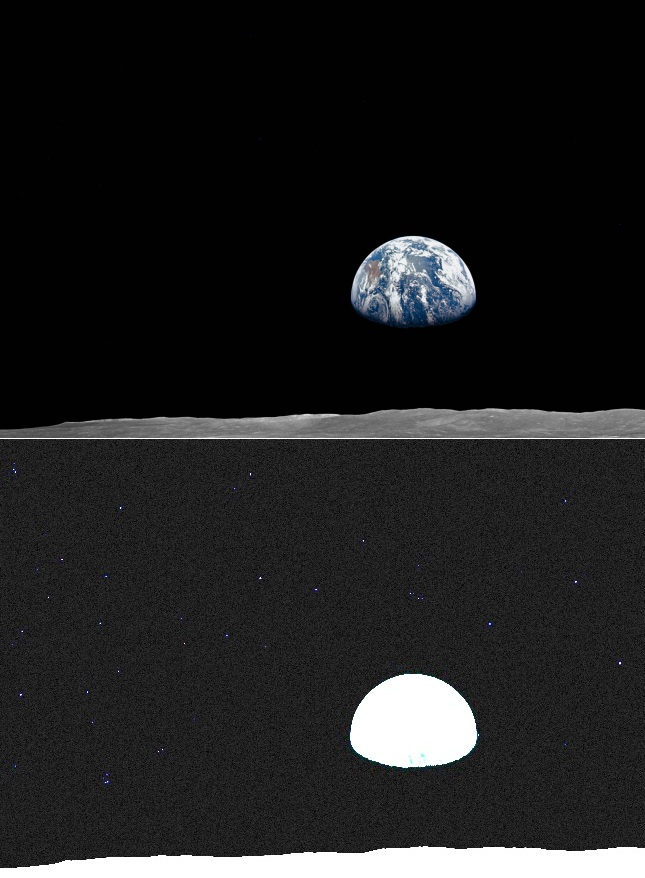
In the original (top panel, cropped and resized, from AS11_AS11-44-6552.tif), the sky appears completely black. However, the contrast-enhanced image (bottom panel) clearly shows what looks like a star field. Interestingly, according to these guys, the original image had been clumsily manipulated by NASA to portray the Moon as gray. NASA subsequently replaced it with a JPEG showing enhanced color saturation, making the Moon appear slightly brownish. That doesn't affect our analysis.
Although the stars in the above image may look like single pixels, a full-size crop (below) shows that they are actually small round disks of various sizes and colors, as would be expected from a real photograph using a high quality photographic lens or small telescope. A small amount of chromatic aberration can be seen here in the the two larger dots. In the original all the stars in the left side of the image appear redder on the right side of the star than on the left, consistent with chromatic aberration and arguing against stuck pixels. No star trailing is evident, which is perhaps not surprising because they are not on the rotating Earth, but in orbit around the Moon. It is clearly also a short exposure, so we would not expect much trailing in any event.
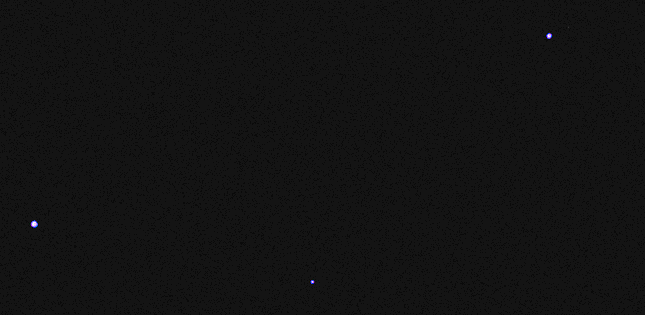
Images taken on the surface of the Moon
The only TIFF file I could find from Apollo 11 is this one of Buzz Aldrin walking near the lunar module in Apollo 11 on July 20, 1969. This image is too grainy to analyze.
Higher quality JPEG images taken with a different camera can be found at nasa.gov. They show what appear to be stars. However, analysis of the images (below) shows that they are not stars, but artifacts in the images.
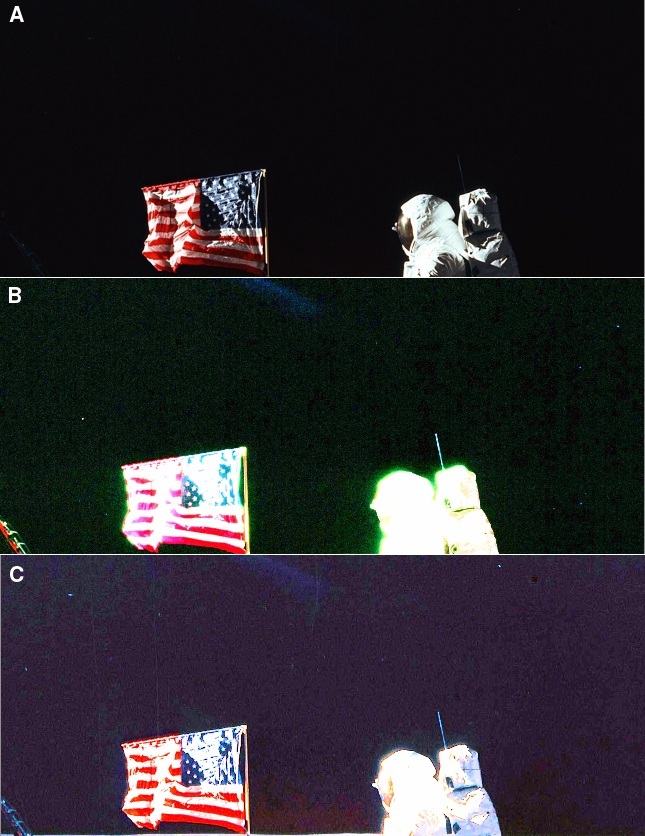
This is the famous image of Buzz Aldrin saluting the American flag.
There are several different versions of this image. Panel A is a cropped and resized version of the original image (AS11-40-5874HR.jpg) from NASA's website. The sky appears solid black. In Panel B, the contrast has been increased to reveal any stars. Panel C is a contrast-enhanced crop of the archive.org) version of the image (GPN-2001-000012.jpg), which was identical to NASA's original except that it had been digitally sharpened by somebody. Both appear to show stars; however, in these images, the stars are all in different locations, indicating that they are not really stars but merely artifacts in the image.
Inspection of the ‘star’ above and to the left of the flag in Panel B (below; pixels reduplicated 4× for clarity) shows it to be a classic blurred hot pixel. (They were using film in those days, so it could be a film artifact in the original. But to me it looks more like an artifact introduced during digitization.)

Computer plate-solving at astrometry.net failed to identify the stars in either of these images or in the Earthrise image above. I was unable to find any good quality images of Apollo 11 in either TIFF or FITS format (the standard file format used by astronomers) at NASA's website. If anyone knows where to find one, please send me a link.
I conclude two things: one, the astronauts were not trying to do astrophotography, but they were highly skilled at taking pictures—there was no motion blurring in any of these images (or, maybe they used a tripod). Two, the JPEG images from NASA are of insufficient quality to determine whether stars are present.
Of course, even if I did identify stars in the Apollo images it might not convince conspiracy theorists. After all, they could say that if stars are visible, NASA could have put them there. So maybe it's lucky I didn't find any.
Modern-day cameras
But this raises another question: is it ever possible to capture a correctly exposed image of the Moon and stars in a single exposure? The answer depends on the dynamic range of the camera. Astronomical cameras can do it, but with a modern-day mid-range digital camera (a Nikon D7000, which has a 14-bit/channel pixel depth in raw mode), in general the answer is no, unless the Moon is way overexposed, obscured by a cloud, or in a crescent phase, or unless the Moon is next to an unusually bright star. Here is an example, taken from somewhere on the planet Earth:
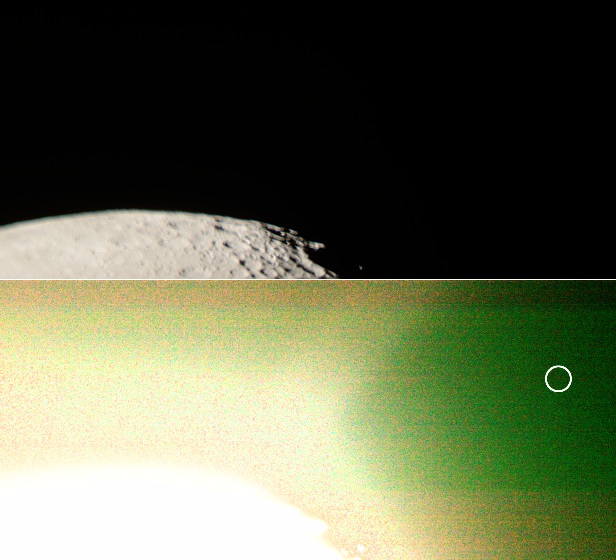
The image above was a 1/5 second exposure taken with a D7000 and an 8-inch Schmidt-Cassegrain telescope. After extensive processing of the original 48-bit image two stars become visible. The brightest one is indicated by a circle in the lower panel.

Here is a full-size crop of the star. The green and orange background is color noise.
A regular camera lens has lower resolution, which makes it tougher to pull stars out of the noise, as the image below shows.
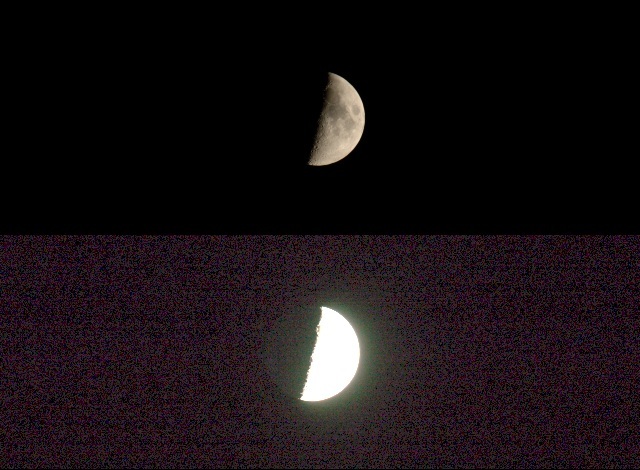
In this image, which is a 1/50 second image taken with a 300mm f/8 lens, no stars are visible at all regardless of what processing is done. This shows that even with modern highly sensitive CMOS sensors it is difficult, though not impossible, to pull stars out of the background unless the Moon is overexposed. (Planets are another matter; Venus and the Moon are a popular combination.)
Film is much less linear than digital sensors, so it's hard to compare them directly. But digitals and film have comparable dynamic range, and even good cameras today would have trouble making stars visible on the Moon without overexposing the foreground.
jan 01, 2016; updated jan 05, 2016

